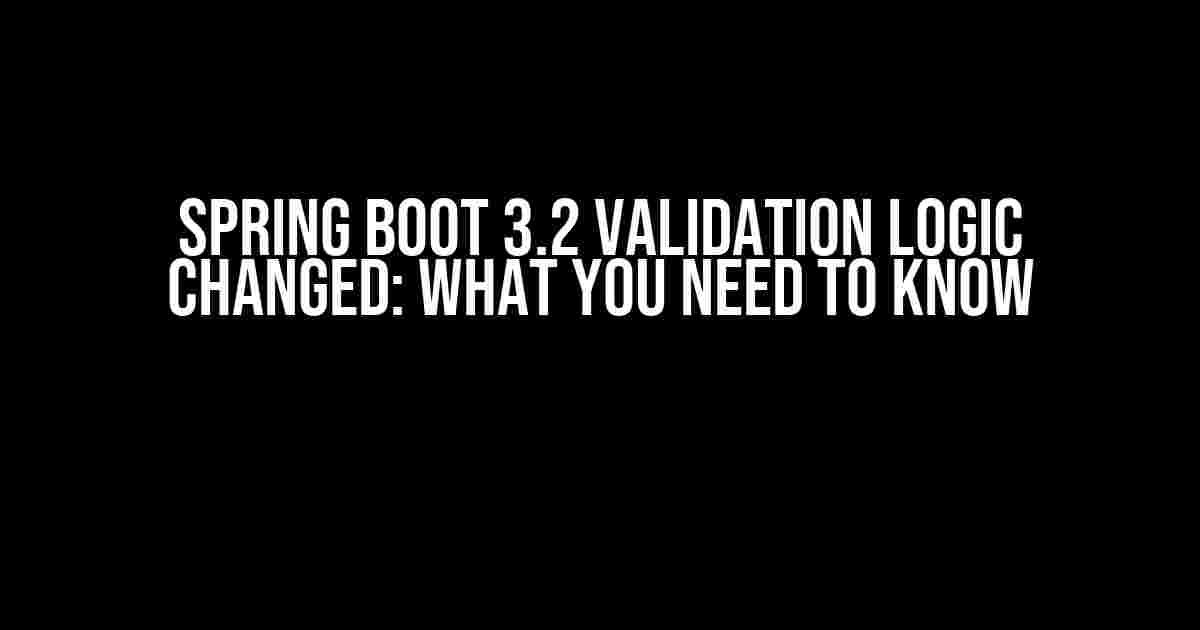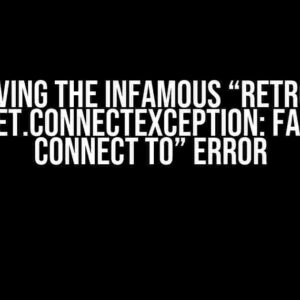Spring Boot 3.2 has brought about a significant change in its validation logic, and as a developer, it’s essential to understand these changes to ensure your applications remain robust and secure. In this article, we’ll delve into the details of the new validation logic, explore the reasons behind the change, and provide a step-by-step guide on how to adapt to these changes.
What’s Changed in Spring Boot 3.2 Validation Logic?
In previous versions of Spring Boot, the validation logic was based on the ` org.springframework.validation` package. However, with the release of Spring Boot 3.2, the validation logic has been rewritten to leverage the Jakarta Bean Validation API (JSR-380). This change brings about a more standardized and flexible approach to validation, but it also requires some adjustments to your existing code.
Why the Change?
The primary reason for this change is to align Spring Boot with the latest Java EE standards. JSR-380 provides a more comprehensive and extensible validation API, which allows for better integration with other Java EE technologies. Additionally, the new validation logic enables more precise control over validation rules, making it easier to handle complex validation scenarios.
Impact on Existing Applications
If you’re upgrading an existing Spring Boot application to version 3.2, you’ll need to make some adjustments to your validation logic. Here are the key areas that will be affected:
- Validation Annotations: The new validation logic uses JSR-380 annotations, such as `@NotBlank`, `@Email`, and `@Pattern`, instead of the older `org.springframework.validation` annotations.
- Validator Interfaces: The `Validator` interface has been replaced by the `jakarta.validation.Validator` interface.
- Validation Configuration: The `validation.properties` file has been deprecated, and you’ll need to use the `application.properties` file to configure validation settings.
Adapting to the New Validation Logic
To adapt to the new validation logic, follow these step-by-step instructions:
Step 1: Update Your Dependencies
In your `pom.xml` file (if you’re using Maven) or your `build.gradle` file (if you’re using Gradle), update your dependencies to include the Jakarta Bean Validation API:
<dependency> <groupId>jakarta.validation</groupId> <artifactId>jakarta.validation-api</artifactId> <version>3.0.2</version> </dependency>
Step 2: Replace Old Validation Annotations
Replace the old `org.springframework.validation` annotations with the new JSR-380 annotations:
| Old Annotation | New Annotation |
|---|---|
| `@org.springframework.validation.annotation.NotNull` | `@jakarta.validation.NotNull` |
| `@org.springframework.validation.annotation.Size` | `@jakarta.validation.constraints.Size` |
| `@org.springframework.validation.annotation.Email` | `@jakarta.validation.constraints.Email` |
Step 3: Update Your Validator Interfaces
Replace the `Validator` interface with the `jakarta.validation.Validator` interface:
@Service
public class MyService {
@Autowired
private jakarta.validation.Validator validator;
public void validationExample() {
// Use the validator instance
}
}
Step 4: Configure Validation Settings
Move your validation configuration from the `validation.properties` file to the `application.properties` file:
spring:
validation:
enabled: true
mode: STRICT
Best Practices for Spring Boot 3.2 Validation
To get the most out of the new validation logic, follow these best practices:
- Use bean validation annotations consistently: Use JSR-380 annotations throughout your application to ensure consistency and ease of maintenance.
- Define validation rules at the bean level: Define validation rules at the bean level using annotations, rather than scattering them throughout your code.
- Use validation groups: Use validation groups to categorize your validation rules and make them more manageable.
- Customize validation messages: Customize validation messages to provide more informative and user-friendly error messages.
Conclusion
The changes to the validation logic in Spring Boot 3.2 may seem daunting, but with this guide, you’ll be well-equipped to adapt to the new validation logic. By following the steps outlined above and adhering to best practices, you’ll be able to take advantage of the improved flexibility and precision of the new validation logic.
Remember, the new validation logic is designed to provide a more standardized and extensible approach to validation, and by embracing these changes, you’ll be able to build more robust and maintainable Spring Boot applications.
Frequently Asked Question
In the latest version of Spring Boot 3.2, several changes have been made to the validation logic. Here are some frequently asked questions and answers about these changes.
What are the main changes in the validation logic of Spring Boot 3.2?
The main changes in the validation logic of Spring Boot 3.2 include the deprecation of the `Validator` interface, the introduction of the `ConstraintValidator` interface, and the ability to define custom validation constraints using the `@Constraint` annotation.
Why was the `Validator` interface deprecated in Spring Boot 3.2?
The `Validator` interface was deprecated in Spring Boot 3.2 because it was deemed too broad and inflexible. The new `ConstraintValidator` interface provides a more targeted and flexible way to validate specific constraints.
How do I define a custom validation constraint in Spring Boot 3.2?
To define a custom validation constraint in Spring Boot 3.2, you need to create a class that implements the `ConstraintValidator` interface and annotates it with the `@Constraint` annotation. You can then use this custom constraint in your application by annotating the relevant fields or methods with the `@Valid` annotation.
What is the impact of the validation logic changes on my existing Spring Boot application?
The impact of the validation logic changes on your existing Spring Boot application will depend on how you are currently using validation in your application. If you are using the `Validator` interface or custom validators, you may need to make changes to your code to adapt to the new validation logic. However, if you are using the built-in validation constraints provided by Spring Boot, such as `@NotNull` or `@Size`, you should not need to make any changes.
Where can I find more information about the validation logic changes in Spring Boot 3.2?
You can find more information about the validation logic changes in Spring Boot 3.2 in the official Spring Boot documentation, as well as in online forums and tutorials. Additionally, you can refer to the Spring Boot 3.2 migration guide, which provides detailed information on the changes and how to adapt your application to the new validation logic.


